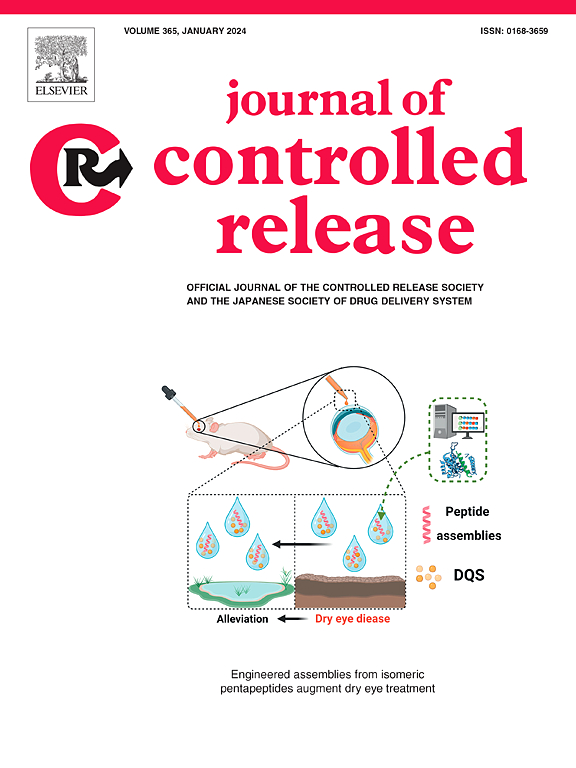Temporal dynamics of neurovascular unit changes following blood-brain barrier opening in the putamen of non-human primates
IF 10.5
1区 医学
Q1 CHEMISTRY, MULTIDISCIPLINARY
引用次数: 0
Abstract
Low-intensity focused ultrasound (LIFU) combined with intravenously circulating microbubbles has recently emerged as a novel approach for increasing delivery through the blood-brain barrier (BBB). This technique safely and transiently enables therapeutic agents to overcome the BBB, which typically poses a significant obstacle for treatment of brain disorders. However, the full impact of LIFU on the entire neurovascular unit (NVU), as well as the mechanisms and factors involved in restoring BBB integrity still require further elucidation.
We conducted immunohistochemical analyses of the putamen in non-human primates to monitor changes over time [immediately post-treatment (3 h) and at 7- and 30-days post-BBB opening] in vascular, glial, and immune cells. Additionally, we examined the dynamic interactions among these elements and their role in the restorative process at the BBB level.
A mild inflammatory response primarily involving microglia, astrocytes, and T- and B-lymphocytes was observed in the treated putamen acutely after BBB opening. These cells, recruited in response to the vascular changes, stimulate upregulation of PDGFRβ, a pericyte-specific marker, and VEGF-A, a pro-angiogenic factor. This was associated with vascular sprouting by 7 days post-BBB opening. Importantly, no notable long-term alterations were observed in the NVU 30 days post-BBB opening.
These results offer further evidence regarding the efficacy and safety of LIFU in achieving BBB opening in the primate brain, indicating that nearly all changes in the NVU revert to baseline within 30 days post-treatment. This also suggests that angiogenesis may play an important role in restoring vascular integrity after BBB opening.
非人灵长类普鲁士脑血脑屏障开放后神经血管单元变化的时间动态。
低强度聚焦超声(LIFU)与静脉循环微气泡相结合,是最近出现的一种通过血脑屏障(BBB)增加给药的新方法。这种技术能安全、瞬时地使治疗药物通过血脑屏障,而血脑屏障通常是治疗脑部疾病的重大障碍。然而,LIFU 对整个神经血管单元(NVU)的全面影响以及恢复 BBB 完整性所涉及的机制和因素仍有待进一步阐明。我们对非人类灵长类动物的大脑丘脑进行了免疫组化分析,以监测血管、神经胶质细胞和免疫细胞随时间(治疗后3小时、BBB开放后7天和30天)的变化。此外,我们还研究了这些元素之间的动态相互作用及其在 BBB 水平恢复过程中的作用。在 BBB 打开后的初期,我们在处理过的大脑皮质中观察到了轻微的炎症反应,主要涉及小胶质细胞、星形胶质细胞、T 淋巴细胞和 B 淋巴细胞。这些因血管变化而被招募的细胞刺激了周细胞特异性标志物 PDGFRβ 和促血管生成因子 VEGF-A 的上调。这与 BBB 开放后 7 天的血管发芽有关。重要的是,BBB 开放后 30 天,在 NVU 中未观察到明显的长期变化。这些结果进一步证明了 LIFU 在灵长类动物大脑中实现 BBB 开放的有效性和安全性,表明 NVU 的几乎所有变化都在治疗后 30 天内恢复到基线。这也表明,血管生成可能在 BBB 开放后恢复血管完整性方面发挥着重要作用。
本文章由计算机程序翻译,如有差异,请以英文原文为准。
求助全文
约1分钟内获得全文
求助全文
来源期刊

Journal of Controlled Release
医学-化学综合
CiteScore
18.50
自引率
5.60%
发文量
700
审稿时长
39 days
期刊介绍:
The Journal of Controlled Release (JCR) proudly serves as the Official Journal of the Controlled Release Society and the Japan Society of Drug Delivery System.
Dedicated to the broad field of delivery science and technology, JCR publishes high-quality research articles covering drug delivery systems and all facets of formulations. This includes the physicochemical and biological properties of drugs, design and characterization of dosage forms, release mechanisms, in vivo testing, and formulation research and development across pharmaceutical, diagnostic, agricultural, environmental, cosmetic, and food industries.
Priority is given to manuscripts that contribute to the fundamental understanding of principles or demonstrate the advantages of novel technologies in terms of safety and efficacy over current clinical standards. JCR strives to be a leading platform for advancements in delivery science and technology.
 求助内容:
求助内容: 应助结果提醒方式:
应助结果提醒方式:


